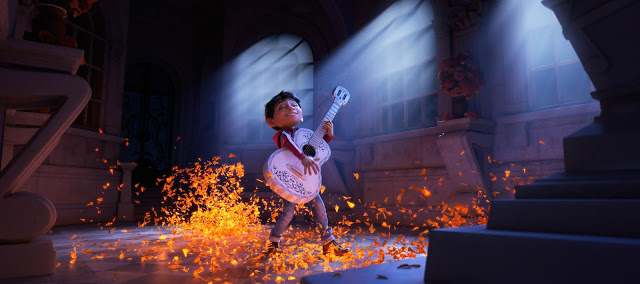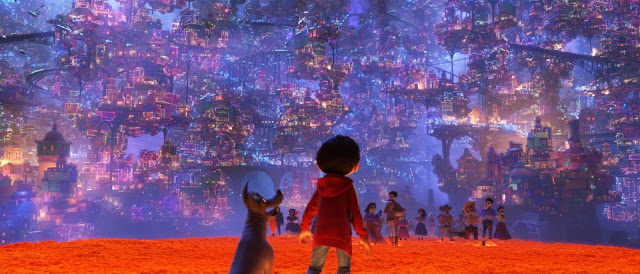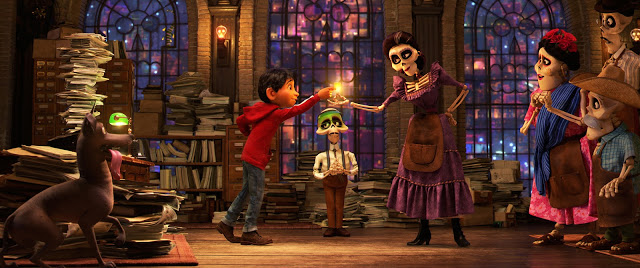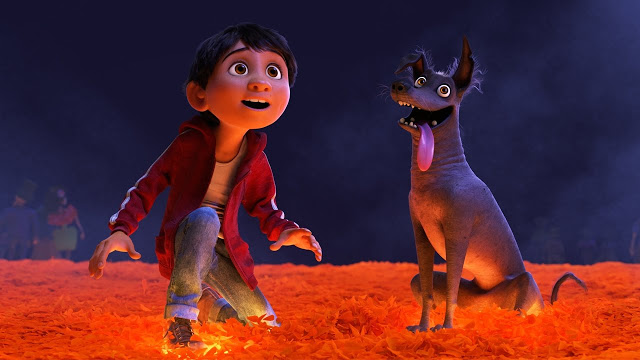Part ticking-clock thriller, part throwback musical, part family weepie, Pixar’s Coco strikes a smart balance between new-age innovation and old-fashioned storytelling. It lacks the creative virtuosity of the studio’s greatest works: the shimmering grandeur of Finding Nemo, the emotional sophistication of Inside Out, the bravura silence of Wall-E. But while Pixar may have previously set the bar for family-friendly entertainment to be unfathomably high, it’s unfair to measure each studio’s new release against its past triumphs. Judged on its own terms, Coco is an agile and rollicking children’s film, mingling spirited action and characteristically stunning technique with wholesome sentimentality. It’s tier-two Pixar, which is another way of saying it’s pretty damn good.
It’s also beautiful, which should go without saying. Visual magnificence is a quality that we take for granted in Pixar productions—it’s simply a matter of appreciating the newest details and the whimsical flourishes within the richly textured environments and limber animation. Coco conjures a world of dazzling luminosity and ceaseless invention: arcing bridges made of bright-orange flower petals; an electric-blue swimming pool in the shape of a guitar; a skylit district of pulsating buildings, threaded together by spiraling staircases and curved viaducts. The characters, meanwhile, move with exquisite dexterity, their wonderfully expressive faces matching the well-pitched vocal performances. The people in this movie look and sound decidedly alive, which is curious, given that most of them are also dead.
Yes, Coco—a plucky and inspirational tale of heroism and self-discovery—takes place in a metaphysical underworld, where skeletons amble about, appendages regularly fall off, and noses are nonexistent. That sounds awfully disturbing, but director Lee Unkrich (Toy Story 3) and his screenwriters (Adrian Molina and Matthew Aldrich) keep the tone light without sacrificing the movie’s dramatic stakes. If anything, Coco spends too long meandering among the living; only once it enters the Land of the Dead does it begin to liven up.
Our spirit guide on this journey into the great beyond is Miguel Rivera (voiced by Anthony Gonzalez), the film’s rather bland 12-year-old protagonist. As established during a brisk prologue—which cleverly plays out via paper figurines—in the distant past, Miguel’s great-great-grandfather abandoned his wife in pursuit of a singing career; ever since, his family has banned music as an accursed pursuit and has instead maintained a cobbling business. Miguel, however, secretly nurses a passion for folk ballads and acoustic pop, and he idolizes Ernesto de la Cruz (Benjamin Bratt), the legendary troubadour whom he suspects may be the very same progenitor who deserted his family for fame all those years ago.
Coco’s opening act is its weakest, painting Miguel’s existential dilemma in broad and clichéd strokes. The concept of overbearing parents (and, in this case, grandparents) obstinately preventing their child from following his dreams is trite, and the particulars of Miguel’s obsession—he watches old VHS tapes of de la Cruz films, and he hones his craft on the guitar in the hope of winning a local talent show—aren’t interesting enough to lend his predicament the necessary freshness.
But once Miguel, thanks to a stolen guitar and a few plot contrivances, finds himself transported to the Land of the Dead, Coco’s individuality starts to materialize. In basic terms, the movie functions as a “race against time” adventure in the vein of Back to the Future, albeit one with its own distinctive flair and comic sensibility. After locating his disapproving undead ancestors—including Imelda (Alanna Ubach), the primordial jilted wife who first instituted the Rivera clan’s ban on music—Miguel learns that if he doesn’t make it home by sunrise, he’ll remain trapped in this netherworld forever. He can only escape if a family member consents, but Imelda conditions his return on the promise that he never play music again. Rather than relinquish his lifelong dream, Miguel resolves to find de la Cruz, convinced that this long-lost relative will help send him home without attaching any poison-pill stipulations.
It’s a complex setup, but there’s enough happening in the frame to prevent Coco from feeling bogged down by clunky exposition or rule-establishing. The Land of the Dead is a realm of (sometimes literal) eye-popping wonders, but it’s also a rigid bureaucracy (recalling the sloth-run DMV in Zootopia) with its own regulations and rituals. That’s indicative of the writers’ thoroughness and intelligence, as are the two characters Miguel ends up teaming up with. One is Héctor (Gael García Bernal), an irritable ex-musician who claims he once knew de la Cruz and who strikes a mutually beneficial bargain with Miguel involving safe passage, singing lessons, and a particularly significant photograph. Héctor’s twitchy annoyance proves a valuable complement to Miguel’s somewhat whiny persistence; they constantly antagonize one another, which is what makes them a good team.
Miguel’s other companion is Dante, a Mexican hairless dog who inadvertently follows the boy into the Land of the Dead and who serves as Coco’s most reliable source of playful amusement. With wide eyes and a long, lolling tongue that seems to be everywhere except in his mouth, Dante can’t speak, but he doesn’t need to, and his abundance of personality demonstrates Unkrich and his crew’s talent for animating expression and emotion. That’s also true of Imelda’s “alebrije”, a sort of spirit animal that hunts Miguel and which takes the form of a brilliantly colored dragon-jaguar hybrid. Like the relentless bird from A Bug’s Life, it’s glimmering and threatening at once, a vibrant force of doom.
As a suspense voyage, Coco is robustly entertaining, and it slyly incorporates several late reveals, one obvious, another genuinely surprising. But the movie has merit beyond its intricately told and earnestly moving story. To begin with, it features a handful of sprightly musical numbers, with some of the songs written by Robert Lopez and Kristen Anderson-Lopez, the duo behind a little film called Frozen. (Speaking of which, Coco is preceded by Olaf’s Frozen Adventure, a well-meaning, interminable fable that follows the holiday escapades of everyone’s favorite dimwitted snowman and that stretches the definition of “short”.) The ditties aren’t quite as spectacular as those of that modern smash, but they’re still reasonably rousing.
They’re also defiantly Latin in style, which is the other interesting thing about Coco: It takes place entirely in Mexico, and its voice cast is populated almost exclusively by Latino actors. That’s obviously a big deal for Disney-Pixar, which continues to take steps to diversify its longstanding whiteness. It’s easy to regard Coco with cynicism: an American mega-corporation seeking to expand the breadth of its territory and co-opt a foreign culture into its merchandising empire. But the movie treats both its subject matter (involving Mexico’s Day of the Dead holiday) and its characters with a sense of respect that’s commendable.
Of course, increased diversity isn’t the only laudable facet of Coco, which will likely be remembered less for its demographics than for its sweeping scope and its soaring imagination. Besides, we don’t need to rush to eulogize the era of Disney monochrome just yet. There are plenty of other dead things in this movie worth celebrating.
Jeremy Beck is the editor-in-chief of MovieManifesto. He watches more movies and television than he probably should.





Important advice: http://www.slate.com/blogs/browbeat/2017/11/26/how_to_avoid_the_frozen_short_and_show_up_late_to_coco.html
Ha. Indeed. Quality #ServiceJournalism from Slate.